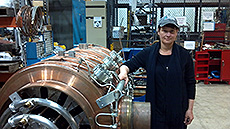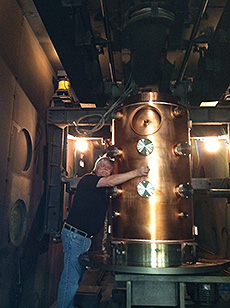Revamped Recycler features new cavity design
 |
Robyn Madrak Plant, APC, and Dave Wildman, APC (below), designed new cavities for the upgraded Recycler. Photo: Dave Wildman
|
When Fermilab’s full accelerator complex kicks back into action this fall, it will bring with it a transition from high energy to high intensity, delivering more beam pulses with more particles. Among the many changes made and new equipment installed during the current shutdown are two new 53 MHz cavities in the Recycler ring, conceived of and designed by Accelerator Physics Center scientists Dave Wildman and Robyn Madrak Plant.
In its new iteration, the Fermilab accelerator complex will perform a process called slip-stacking in the Recycler Ring. Slip-stacking combines batches of protons to make a more intense beam. Before the shutdown, slip-stacking and acceleration couldn’t happen at the same time because the Recycler was used to store antiprotons; now, slip-stacking of protons can take place in the Recycler while the Main Injector accelerates another set of particle batches and fires them to various experimental areas. Instead of delivering proton pulses every 2.2 seconds, the Main Injector will now fire a pulse every 1.3 seconds.
“Instead of having to slip-stack in the Main Injector and then accelerate, we can be slip-stacking and accelerating at the same time,” Madrak Plant said. “Ultimately you get more beam through that way.”
The Main Injector previously had 18 cavities, which were essential for accelerating the beam, but they were not ideal for slip-stacking.
“The previous cavities were designed for accelerating a small amount of beam to very high energies very fast,” Wildman said. “In the future, we want to deliver lots of beam, high-intensity beam, so we need cavities that had different parameters. That’s what these cavities are.”
It took Wildman and Madrak Plant five years to see their cavities move from concept to reality. The idea for the cavities, which are now installed in the Recycler ring to perform the slip-stacking, came in part from a much smaller one designed about 20 years ago for the Main Ring accelerator. Then, Wildman and Madrak Plant built a prototype out of sheet metal, which allowed them to study their design and measure electrical parameters.
The new type of cavity is made out of solid blocks of high-conductivity, oxygen-free copper shipped from Japan. The block was heated in an oven for two days, then shaped into two large tubes. The tubes were welded together, one inside of the other, on one end. On the other end there is a gap with a large electric field. The voltage across the gap keeps the beam circulating in the machine at the desired frequency.
While the Recycler ring is being reused for slip-stacking, the cavity RF systems themselves feature recycled parts: Three RF stations from the Tevatron provide power to the new cavities, which saving money and reducing waste.
Accelerator operators expect to send first beam through the revamped Recycler in the next couple of months.
—Laura Dattaro
 |
Dave Wildman helps with construction of one of the cavities. Photo: Jim Wilson, AD
|
|